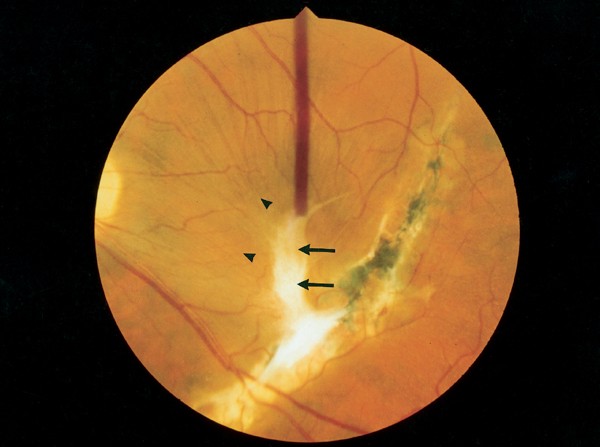Play all audios:
MAIN Sir, Fibrocellular epiretinal membrane formation and subretinal neovascularisation (SRN) are documented sequelae of traumatic choroidal rupture. We herein report a case that illustrates
the development of these complications at different time points following injury and the successful surgical management of both pathologies. CASE REPORT An 18-year-old male sustained a left
closed-globe contusion injury in a road traffic accident, and developed vitreous haemorrhage. He was referred for vitreoretinal management 3 months later following initial observation at a
local hospital. His visual acuity was 6/12 with marked distortion. Fundoscopy revealed a crescent-shaped choroidal rupture concentric to the optic disc and an epiretinal membrane extending
from the rupture (Figure 1). His vision returned to 6/6 after vitrectomy and surgical peeling of this membrane, despite a faint subretinal haemorrhage. Fluorescein angiography confirmed a
subretinal neovascular membrane extending from the rupture towards the fovea (Figure 2a). Given his good visual acuity, and previous experience of spontaneous neovascular membrane
regression, we elected to observe his progress. After 4 months, his visual acuity was 6/12 and the membrane had extended subfoveally (Figure 2b). Surgical removal of the membrane was
planned, prior to which his visual acuity had deteriorated to 6/24 with clinical evidence of membrane extension and increased subretinal haemorrhage. Following surgical removal via a small
retinotomy nasal to the choroidal rupture, his vision improved and was stable at 6/9 (with no significant distortion) 3 months after surgery, without membrane recurrence. Histological
examination of the subretinal neovascular membrane demonstrated RPE cells on one surface and within a fibrovascular core, and no evidence of photoreceptors or Bruchs membrane components.
COMMENT This patient demonstrates two complications of blunt ocular trauma:1 epiretinal membrane formation and SRN.1,2 The sequential development of these complications has not previously
been reported in the same patient. The case supports previous reports of successful management of subretinal neovascular membranes secondary to blunt ocular trauma by surgical removal.3,4
The clinical behaviour and pathological appearance of the subretinal neovascular membrane in this case suggests that it was a ‘type 2’ membrane5 (ie neovascularisation below neurosensory
retina but internal to viable RPE), increasing the likelihood of a good visual outcome from subretinal surgery. Gass has previously noted that choroidal neovascularisation arising at the
site of an old choroidal rupture is usually type 2.6 Glial proliferation has a central role in epiretinal membrane formation—retinal glial cells can extend through defects in the inner
limiting membrane (ILM), and may also be capable of producing ILM breaks through which they can extend processes onto the ILM surface.7 In the case we have described, the epiretinal membrane
appeared to extend from the choroidal rupture towards the fovea. It is likely that inner retinal disruption and microscopic breaks in the ILM at the time of traumatic choroidal rupture
provided the basis for subsequent glial extension and epiretinal membrane formation. In addition, the fibroglial scar at the site of the choroidal rupture provides an anchor for the
epiretinal membrane, any subsequent membrane contraction enhancing the clinical appearance of the membrane extending from the rupture. Management of epiretinal membranes invariably involves
vitrectomy surgery; however, other treatment options are now available for SRN. Photodynamic therapy (PDT) may limit progression (although not widely available at the time of presentation of
this case) in some age-related macular degeneration SRN; however, the value of PDT in post-trauma SRN is unproven. Likewise, trans-pupillary thermotherapy may offer a benefit in SRN
treatment, but its efficacy requires further investigation. It is uncertain whether any of the alternative novel treatment options for SRN could result in a visual improvement from 6/24 to
6/9, which was achieved by surgical management of the SRN in this case. REFERENCES * Williams DF, Mieler WF, Williams GA . Posterior segment manifestations of ocular trauma. _Retina_ 1990;
10: S35–S44. Article Google Scholar * Smith RE, Kelley JS, Harbin TS . Late macular complications of choroidal ruptures. _Am J Ophthalmol_ 1974; 77: 650–658. Article CAS Google Scholar
* Aguilar JP, Green WR . Choroidal rupture: a histopathologic study of 47 cases. _Retina_ 1984; 4: 269–275. Article CAS Google Scholar * Gross JG, King LP, de Juan Jr E, Power T .
Subfoveal neovascular membrane removal in patients with choroidal rupture. _Ophthalmology_ 1996; 103: 579–585. Article CAS Google Scholar * Grossniklaus HE, Gass JDM . Clinicopathological
correlations of surgically excised type 1 and type 2 submacular choroidal neovascular membranes. _Am J Ophthalmol_ 1998; 126: 59–69. Article CAS Google Scholar * Gass JDM . Traumatic
choroidopathy. In: _Stereoscopic Atlas of Macular Diseases_, VOL 1, 4th ed. CV Mosby: St Louis, 1997, pp 206–208. Google Scholar * McLeod D, Hiscott P, Grierson I . Age-related cellular
proliferation at the vitreoretinal juncture. _Eye_ 1987; 1: 263–281. Article Google Scholar Download references AUTHOR INFORMATION AUTHORS AND AFFILIATIONS * Vitreoretinal Research
Department Moorfields Eye Hospital, City Road, London, EC1V 2PD, UK E V Gotzaridis, A N Vakalis, C S Sethi & D G Charteris Authors * E V Gotzaridis View author publications You can also
search for this author inPubMed Google Scholar * A N Vakalis View author publications You can also search for this author inPubMed Google Scholar * C S Sethi View author publications You can
also search for this author inPubMed Google Scholar * D G Charteris View author publications You can also search for this author inPubMed Google Scholar CORRESPONDING AUTHOR Correspondence
to D G Charteris. RIGHTS AND PERMISSIONS Reprints and permissions ABOUT THIS ARTICLE CITE THIS ARTICLE Gotzaridis, E., Vakalis, A., Sethi, C. _et al._ Surgical removal of sequential
epiretinal and subretinal neovascular membranes in a patient with traumatic choroidal rupture. _Eye_ 17, 790–791 (2003). https://doi.org/10.1038/sj.eye.6700472 Download citation * Published:
20 August 2003 * Issue Date: 01 August 2003 * DOI: https://doi.org/10.1038/sj.eye.6700472 SHARE THIS ARTICLE Anyone you share the following link with will be able to read this content: Get
shareable link Sorry, a shareable link is not currently available for this article. Copy to clipboard Provided by the Springer Nature SharedIt content-sharing initiative

